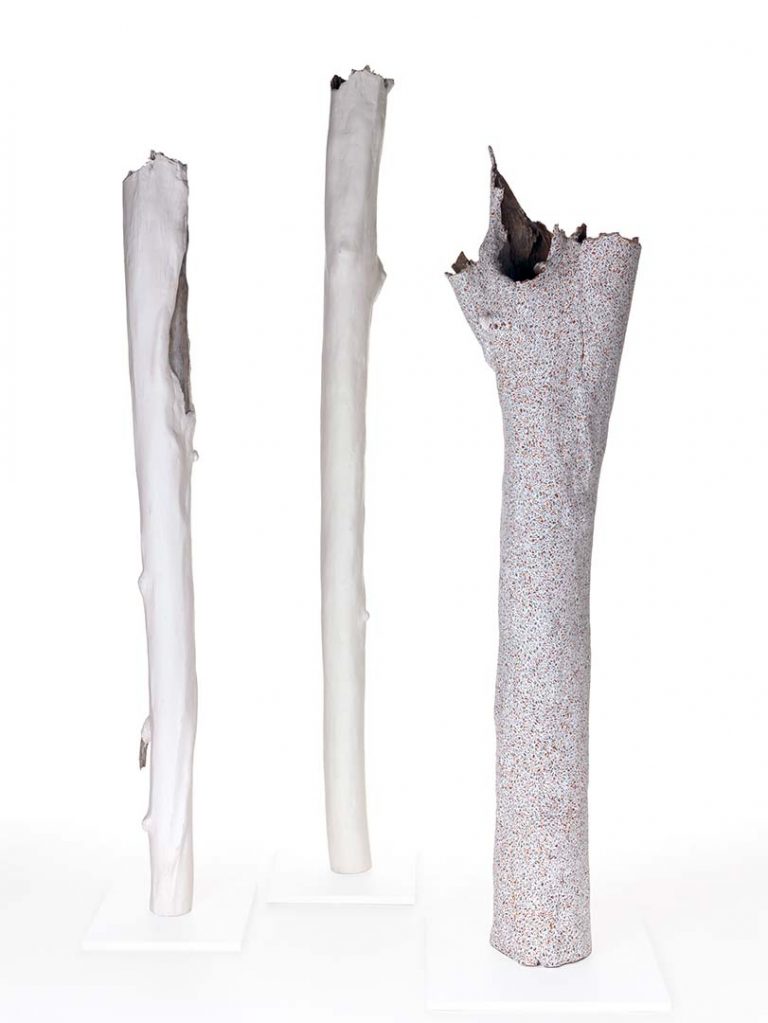We acknowledge the Traditional Owners of the land on which the Queensland Art Gallery | Gallery of Modern Art stands and recognise the creative contribution First Australians make to the art and culture of this country.

Wukun Wanambi / Marrakulu, Dhurili people / Australia b.1962 / Larrakitj 2017 / Wood with white clay pigment / 240 x 17cm (diam) / Larrakitj 2017 / Wood with white clay pigment / 270 x 18cm (diam.) / Wawurritjpal (Larrakitj) 2017 / Wood with natural pigment / 244 x 50cm (diam., irregular) / Purchased 2017 with funds from Pamela, Michael and Jane Barnett through the Queensland Art Gallery l Gallery of Modern Art Foundation / Collection: Queensland Art Gallery | Gallery of Modern Art, Brisbane / © Wukun Wanambi
Wukun WanambiLarrakitj, Larrakitj, Wawurritjpal (Larrakitj) 2017
On Display: GOMA, Gallery 3.2
Wukun Wanambi’s Larrakitj, Larrakitj and Wawurritjpal (Larrakitj) 2017 are three hollow logs that represent three important granite rocks in the waters of Trial Bay, eastern Arnhem Land, in the Northern Territory.
Wawurritjpal (Larrakitj) refers to Bamurrungu, the sacred rock that rises above the waters where the wawurritjpal (sea mullet) gather. The mullet form a column and appear to explode to the surface with great energy — a movement depicted by Wanambi on the surface of the pole. Bamurrungu is believed to be a hollow rock through which the seawater rushes, creating bubbles that the Marrakulu people see as a life force and a direct connection to the ancestors.
In this installation, the artist refers to his developmental process, showing the ‘blank canvas’ of two stark, unembellished larrakitj painted with gapan (white clay), in contrast with Wawurritjpal (Larrakitj) with hundreds of small fish scattered across its surface.
Wukun Wanambi was born in eastern Arnhem Land into the Marrakulu and Dhurili people. He began painting in 1997 as part of the Saltwater Project, a collective painting project supporting claims to sea rights. His arm of the Marrakulu clan is responsible for saltwater imagery, and the djunggayi(a) (caretakers) — in particular, Yanggarriny Wunungmurra (1932–2003) — transferred their knowledge of these designs to Wanambi so that the title to saltwater could be asserted.
For Wanambi, art is an important platform for sharing the power of Yolngu culture, developing and maintaining its histories and expressing his own personal aesthetic. Wanambi works primarily with traditional ochres on eucalyptus bark and larrakitj (memorial poles).
Larrakitj (memorial poles) are traditional coffins: hollowed logs, painted with clan designs, that contained the remains of certain deceased people and were allowed to deteriorate naturally in the elements. Wanambi says of his larrakitj: ‘In Yolngu, understanding the life of the spirit is a circle. The larrakitj is a circle . . . The body dissolves and the bones return to the land as the larrakitj decays’.1
Endnotes:
1 Wukun Wanambi, quoted in ‘Unsettled: Stories Within — Wukun Wanambi’, National Museum of Australia, <https://www.nma.gov.au/exhibitions/unsettled/wukun-wanambi>, viewed November 2019.
Discussion
1. Wanambi wants us to understand his larrakitj as representative of a circle. How many references to circles or cycles can you find layered into the work?
2. Write a list of words to describe the movement and pattern of the sea mullet on Wawurritjpal. Choose one of these words and draw your own representation of the movement.
3. Wanambi leaves the natural cracks and irregularities of the timber largely unmodified. How do these features contribute to the aesthetic qualities of the work?
Activities
1. Investigate the movement of sea creatures, such as fish, crabs or octopuses. Create a visual representation of this movement by repeating the image of your chosen creature.
2. With a partner, trace the outline of your body on a concrete path with chalk. Working within the shape of your own body, using marks, symbols, and colours to express your own relationship with water.
3. Choose an object that has a personal connection to your family. Cover the object with a repeated motif that communicates a specific memory or story featuring this object.